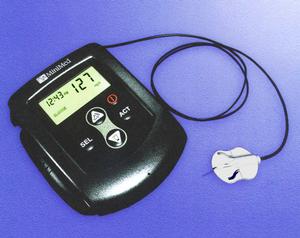This page as a pdf file
Continuous Glucose Monitoring System
Information about the MiniMed Continuous Glucose Monitoring System
The MiniMed Continuous Glucose Monitoring System (otherwise known as a sensor) is a device which is implanted under the skin and takes a blood glucose measurement every 5 minutes throughout the day and night, for up to 3 days. Currently, the results are not viewable instantly, but have to be downloaded later to a computer. This enables you and your doctor to see exactly what is happening to your blood glucose levels round the clock. The system can be used to detect unknown hypos and highs (e.g. at night), and give you a much better picture of what is really going on.
Picture of MiniMed Continuous Glucose Monitoring System

The sensor is inserted under the skin in a similar manner to the infusion set of a pump, and is connected to a small pager-sized monitor (again, worn like a pump). An electronic signal proportional to the blood glucose level is transmitted to the monitor. When the device is removed, the monitor is connected to a computer, and the results downloaded and displayed. According to MiniMed, results of clinical trials so far have shown that a far greater incidence of variability in blood glucose levels is detected via this method than via traditional blood glucose monitoring, and in particular, a high incidence of previously undetected night-time hypos.
The system is currently intended for occasional use, under the supervision of a doctor, in order to guide future management of the patient's diabetes. Since 1 June 2000, it has been available in the UK, and several hospitals have purchased them for trial purposes.
Further information can be found at the MiniMed website, or by emailing cgms@minimed.com
Sarah Davies <me@sarahdavis50.freeserve.co.uk>, is a nurse employed by MiniMed as a pump trainer. She has diabetes herself and recently used the glucose sensor. She writes:
I wore the glucose sensor for 2 days and found the data extremely useful. I have been on a MiniMed pump for 5 years and at the time of wearing the sensor I was using Actrapid in the pump.
Results
- Overall my boluses were not quite big enough to prevent slight post-prandial hyperglycaemia, particularly at breakfast;
- My overnight basal rates were shown to be correct;
- During exercise my blood sugars dropped quite sharply;
- A hypo during the exercise was overcorrected.
Action
- I've switched to Humalog following these results and increased by boluses slightly;
- I've decreased my daytime basal rates;
- I take less to correct hypos;
- I eat a longer acting CHO snack before exercise.
My blood sugars have improved as a consequence and I feel reassured from the data that my basal rates overnight are correct and nocturnal hypoglycaemia is not a concern.
See also our special page on wearing a continuous glucose sensor by John Davis.
For a detailed account of an American lady's experiences using a glucose monitor for 3 days, see Mary Jean's Day on the Insulin Pumpers US website.
Created: Sep 2000; Last updated: Wednesday 14 September 2005
Other pages about blood testing
[ Wearing a continuous glucose sensor | My CGMS test | CGMS accuracy | Continuous Glucose Monitoring System | Cygnus GlucoWatch | Hypo review ]
Reader comments
-
On 19 Nov 2000 Ansky428 wrote:
I am doing a project on diabetes for my health class and your web site is so great for pics and research. Thanks a lot!
